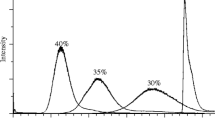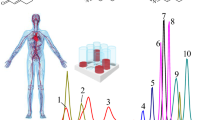Abstract
An in vitro steroidogenesis assay using H295R human adenocarcinoma cells is a useful tool for the fast identification of compounds that affect the production of testosterone and 17β-estradiol. Selective and sensitive hormone measurement by liquid chromatography–tandem mass spectrometry (LC–MS/MS) can make this assay more reliable. Therefore, in the present study, a sensitive and selective method for the quantification of testosterone and 17β-estradiol in the H295R steroidogenesis assay was developed and fully validated using LC–MS/MS coupled with an online sample enrichment technique. To prove its usefulness, the method developed was applied to investigate the effect of sildenafil on steroidogenesis. Cell medium samples were diluted and prepared using solid-phase extraction. The samples were prepared on ice and were not kept for more than 30 min to prevent degradation of hormones. The extracts were dried, reconstituted, filtered, and analyzed by LC–MS/MS with polarity switching electrospray ionization. The validation results for selectivity, matrix effect, recovery, linearity, precision, and accuracy were satisfactory. The limits of detection for testosterone and 17β-estradiol were 5 and 10 pg/mL, respectively, and the limit of quantification for both testosterone and 17β-estradiol was 10 pg/mL, which was in accordance with the OECD guideline. No degradation was observed under the storage conditions for 7 and 14 days at -80 °C as well as after three freeze–thaw cycles, whereas 17β-estradiol was degraded after 1 h on ice during sample processing. The method developed was successfully used for the investigation of the effect of sildenafil on steroidogenesis. This method can be very useful for the initial selection of drugs with androgenic and/or estrogenic effects for specific purposes, e.g., in the selection of drugs that are used to reverse the effects of chemical castration.




Similar content being viewed by others
References
Royal Society of Chemistry (2103) ChemSpider | search and share chemistry. http://www.chemspider.com/. Accessed 28 Mar 2013
OECD (2011) OECD guideline for the testing of chemicals. H295R steroidogenesis assay. Available via http://www.oecd-ilibrary.org/environment/test-no-456-h295r-steroidogenesis-assay_9789264122642-en;jsessionid=1cvkm6stbtd3m.x-oecd-live-01. Accessed 28 Mar 2013
Rijk JC, Peijnenburg AA, Blokland MH, Lommen A, Hoogenboom RL, Bovee TF (2012) Screening for modulatory effects on steroidogenesis using the human H295R adrenocortical cell line: a metabolomics approach. Chem Res Toxicol 25:1720–1731
Rosenmai AK, Nielsen FK, Pedersen M, Hadrup N, Trier X, Christensen JH, Vinggaard AM (2012) Fluorochemicals used in food packaging inhibit male sex hormone synthesis. Toxicol Appl Pharmacol 266:132–142
Li Z, Yin N, Liu Q, Wang C, Wang T, Wang Y, Qu G, Liu J, Cai Y, Zhou Q, Jiang G (2012) Effects of polycyclic musks HHCB and AHTN on steroidogenesis in H295R cells. Chemosphere 90:1227–1235
Ma Y, Han J, Guo Y, Lam PK, Wu RS, Giesy JP, Zhang X, Zhou B (2012) Disruption of endocrine function in in vitro H295R cell-based and in in vivo assay in zebrafish by 2,4-dichlorophenol. Aquat Toxicol 106–107:173–181
Kolle SN, Ramirez T, Kamp HG, Buesen R, Flick B, Strauss V, van Ravenzwaay B (2012) A testing strategy for the identification of mammalian, systemic endocrine disruptors with particular focus on steroids. Regul Toxicol Pharmacol 63:259–278
Nielsen FK, Hansen CH, Fey JA, Hansen M, Jacobsen NW, Halling-Sørensen B, Björklund E, Styrishave B (2012) H295R cells as a model for steroidogenic disruption: a broader perspective using simultaneous chemical analysis of 7 key steroid hormones. Toxicol In Vitro 26:343–350
van der Pas R, Hofland LJ, Hofland J, Taylor AE, Arlt W, Steenbergen J, van Koetsveld PM, de Herder WW, de Jong FH, Feelders RA (2012) Fluconazole inhibits human adrenocortical steroidogenesis in vitro. J Endocrinol 215:403–412
Zhang F, Rick DL, Kan LH, Perala AW, Geter DR, LeBaron MJ, Bartels MJ (2011) Simultaneous quantitation of testosterone and estradiol in human cell line (H295R) by liquid chromatography/positive atmospheric pressure photoionization tandem mass spectrometry. Rapid Commun Mass Spectrom 25:3123–3130
Dinh QT, Alliot F, Moreau-Guigon E, Eurin J, Chevreuil M, Labadie P (2011) Measurement of trace levels of antibiotics in river water using on-line enrichment and triple-quadrupole LC-MS/MS. Talanta 85:1238–1245
König S, Aebi B, Lanz S, Gasser M, Weinmann W (2011) On-line SPE LC-MS/MS for the quantification of Δ9-tetrahydrocannabinol (THC) and its two major metabolites in human peripheral blood by liquid chromatography tandem mass spectrometry. Anal Bioanal Chem 400:9–16
Heinig K, Wirz T, Bucheli F, Monin V, Gloge A (2011) Sensitive determination of a pharmaceutical compound and its metabolites in human plasma by ultra-high performance liquid chromatography-tandem mass spectrometry with on-line solid-phase extraction. J Pharm Biomed Anal 54:742–749
Park M, Ahn S (2012) Quantitative analysis of sildenafil and tadalafil in various fake drugs recently distributed in Korea. J Forensic Sci 57:1637–1640
Ortiz RS, Mariotti KC, Schwab NV, Sabin GP, Rocha WF, de Castro EV, Limberger RP, Mayorga P, Bueno MI, Romão W (2012) Fingerprinting of sildenafil citrate and tadalafil tablets in pharmaceutical formulations via X-ray fluorescence (XRF) spectrometry. J Pharm Biomed Anal 58:7–11
Sacré PY, Deconinck E, Chiap P, Crommen J, Mansion F, Rozet E, Courselle P, De Beer JO (2011) Development and validation of a ultra-high-performance liquid chromatography-UV method for the detection and quantification of erectile dysfunction drugs and some of their analogues found in counterfeit medicines. J Chromatogr A 1218:6439–6447
Lee S, Kang SY, Ji D, Baeck S, Lee S, Oh SM, Chung KH (2013) Quantitative LC-MS/MS method in urine for the detection of drugs used to reverse the effects of chemical castration. Anal Bioanal Chem 405:3185–3194
Taxvig C, Elleby A, Sonne-Hansen K, Bonefeld-Jørgensen EC, Vinggaard AM, Lykkesfeldt AE, Nellemann C (2010) Effects of nutrition relevant mixtures of phytoestrogens on steroidogenesis, aromatase, estrogen, and androgen activity. Nutr Cancer 62:122–131
Matuszewski BK, Constanzer ML, Chavez-Eng CM (2003) Strategies for the assessment of matrix effect in quantitative bioanalytical methods based on HPLC-MS/MS. Anal Chem 75:3019–3030
Peters FT, Drummer OH, Musshoff F (2007) Validation of new methods. Forensic Sci Int 165:216–224
Janjic MM, Stojkov NJ, Bjelic MM, Mihajlovic AI, Andric SA, Kostic TS (2012) Transient rise of serum testosterone level after single sildenafil treatment of adult male rats. J Sex Med 9:2534–2543
Sharma V, Thakur M, Dixit VK (2012) A comparative study of ethanolic extracts of Pedalium murex Linn. fruits and sildenafil citrate on sexual behaviors and serum testosterone level in male rats during and after treatment. J Ethnopharmacol 143:201–206
Andric SA, Janjic MM, Stojkov NJ, Kostic TS (2010) Sildenafil treatment in vivo stimulates Leydig cell steroidogenesis via the cAMP/cGMP signaling pathway. Am J Physiol Endocrinol Metab 299:E544–E550
Saraiva KL, Silva AK, Wanderley MI, De Araújo AA, De Souza JR, Peixoto CA (2009) Chronic treatment with sildenafil stimulates Leydig cell and testosterone secretion. Int J Exp Pathol 90:454–462
Acknowledgments
This research was conducted with the help of a Settlement Research Grant from Keimyung University in 2012. The authors would like to thank Hyoyoung Kim at Agilent Technologies Korea for his technical support.
Author information
Authors and Affiliations
Corresponding author
Rights and permissions
About this article
Cite this article
Kang, S., Park, S., Kim, M.J. et al. A sensitive and selective LC-MS/MS analysis coupled with an online sample enrichment technique for H295R steroidogenesis assay and its application in the investigation of the effect of sildenafil on steroidogenesis. Anal Bioanal Chem 405, 9489–9496 (2013). https://doi.org/10.1007/s00216-013-7380-5
Received:
Revised:
Accepted:
Published:
Issue Date:
DOI: https://doi.org/10.1007/s00216-013-7380-5




